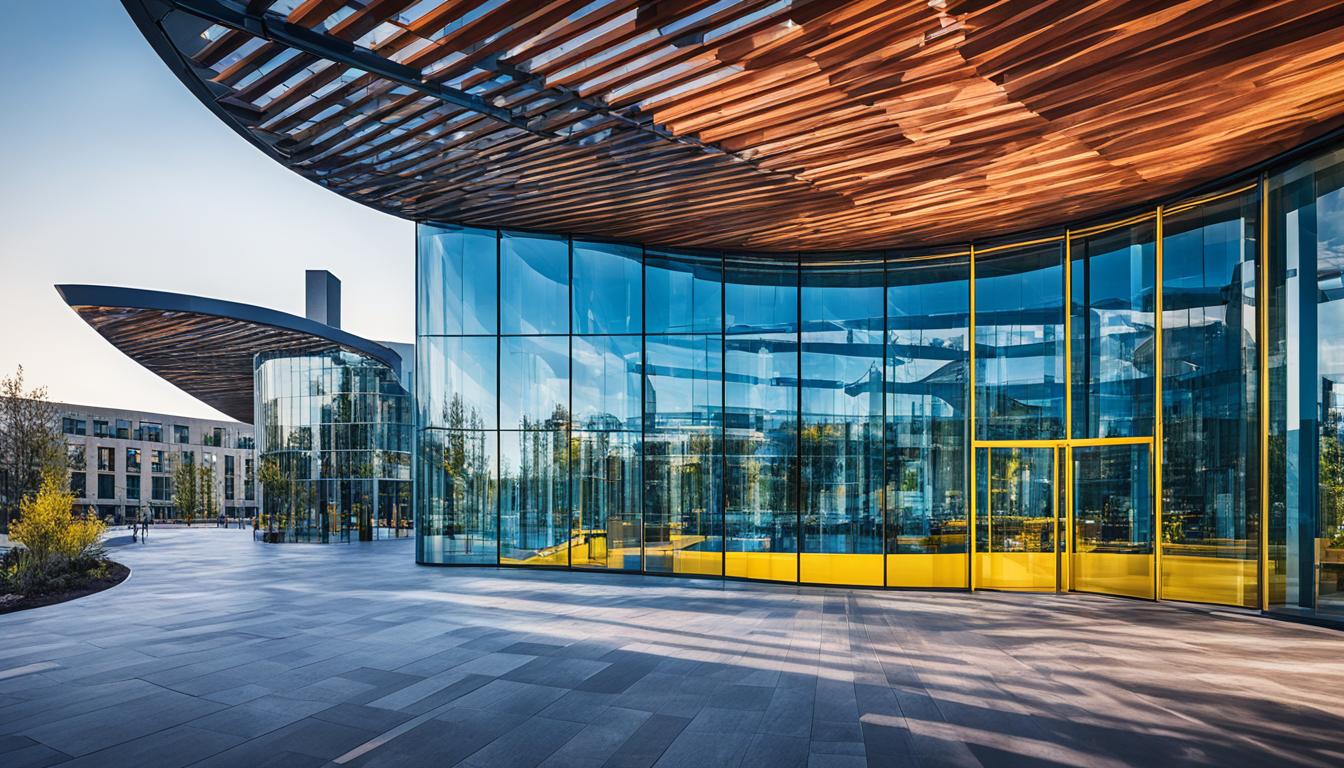Welcome to our guide on architectural photography post-processing techniques! As photographers, we understand the importance of capturing the beauty and grandeur of architectural designs. However, to truly showcase the essence of these structures, editing is often necessary. In this article, we will explore the world of architectural photography post-processing, discussing techniques and tools that can enhance your photos and take them to new heights.
Editing architectural photos requires special attention to detail and an understanding of the unique challenges in this genre. By employing the right techniques, you can transform your images into captivating masterpieces that leave a lasting impression.
Key Takeaways:
- Architectural photography post-processing can significantly enhance the visual appeal of your shots.
- Techniques such as perspective correction, distraction removal, and detail enhancement are crucial for architectural photo enhancement.
- Following a structured retouching workflow helps maintain consistency and efficiency in editing.
- Utilize non-destructive editing techniques to preserve the original image’s integrity.
- With practice and attention to detail, you can create stunning architectural photographs that showcase the beauty of the structures.
Perspective Correction for Architectural Photography
Perspective plays a significant role in capturing accurate representations of buildings and structures in architectural photography. Perspective distortion, such as skewed vertical or horizontal lines, can occur due to camera lens limitations. To correct perspective in architectural photos, we rely on the powerful Transform tool. This tool allows us to manipulate perspective, straighten vertical and horizontal lines, and ensure buildings look aligned and balanced.
Correcting both vertical and horizontal perspectives is crucial to maintain the integrity of architectural images. By using the Transform tool, we can achieve vertical perspective correction to ensure that tall buildings appear upright. This correction avoids the distracting effect of leaning or distorted vertical lines. Additionally, horizontal perspective correction helps in straightening out any visible tilts or bending in the horizontal lines, resulting in a more natural and appealing composition.
While perspective correction is essential, it’s equally important to strike a balance. Over-correction can lead to unnatural or distorted results, which can detract from the authenticity of the architectural subject. Balancing perspective corrections ensures that the final image maintains a sense of realism and accurately represents the architecture being photographed.
| Benefits of Perspective Correction in Architectural Photography |
|---|
| – Straightening vertical lines |
| – Straightening horizontal lines |
| – Balancing perspective corrections to maintain authenticity |
By utilizing perspective correction techniques with the Transform tool, we can elevate our architectural photographs and bring out the true beauty of the buildings and structures we capture.
Removing Distractions and Enhancing Architectural Details
In architectural photography, capturing the essence of a building and showcasing its beauty requires meticulous attention to detail. To achieve this, it is crucial to remove distractions that may hinder the viewer’s focus and enhance the architectural details that make the structure unique.
When it comes to removing distractions, advanced retouching techniques can be employed. The content-aware fill feature is an invaluable tool that seamlessly removes unwanted elements like people, vehicles, or objects obstructing the view. By intelligently analyzing the surrounding areas, this tool fills in the gaps, creating a clean and distraction-free composition.
Another powerful tool in an architectural photographer’s arsenal is the clone stamp tool. This tool allows for precise removal of distractions by sampling an area of the image and stamping it over the unwanted element. With proper skill and technique, the clone stamp tool can effectively remove distractions while maintaining the integrity of the original image.
Enhancing architectural details is equally essential in creating captivating photographs. By adjusting contrast, clarity, and sharpening, photographers can bring out the textures and intricacies of various architectural elements. Stone, glass, metal, and other materials can be accentuated, highlighting their unique characteristics and adding depth to the composition. It’s essential to strike a balance between enhancing details and maintaining a natural and realistic look.
Architectural details, such as columns, arches, or ornate decorations, deserve special attention. By emphasizing these features, photographers can draw the viewer’s attention to the intricate craftsmanship that went into constructing the building. This enhances the visual impact of the photograph and showcases the architectural design in all its glory.
Example of Enhancing Architectural Details

The image above demonstrates the power of enhancing architectural details. By adjusting contrast and sharpening, the unique textures and patterns of the building’s facade are enhanced, bringing the architecture to life.
| Enhancement Technique | Description |
|---|---|
| Contrast Adjustment | Increases the difference between light and dark areas, enhancing the overall tonal range and defining architectural details. |
| Sharpening | Enhances edge definition and brings out fine details, resulting in a crisper and more visually engaging photograph. |
By employing these techniques and giving careful consideration to removing distractions and enhancing architectural details, photographers can transform their architectural photographs into captivating masterpieces. The combination of removing distractions and accentuating intricate elements elevates the visual appeal of the images, allowing viewers to fully appreciate the architectural marvels captured through the lens.
A Structured Retouching Workflow for Architectural Photography
To achieve consistent and efficient results in architectural photography post-processing, we follow a structured retouching workflow. This ensures that our editing process is systematic and delivers high-quality results. Let’s dive into the key steps of our workflow.
Basic Adjustments
We begin by making basic adjustments to the architectural photo. This includes fine-tuning the exposure, adjusting the white balance, and cropping the image to improve its composition. These initial adjustments lay the foundation for the rest of the editing process, setting the stage for a visually appealing final result.
Perspective Correction
Perspective correction is crucial in architectural photography to ensure that vertical and horizontal lines appear straight and accurate. Using specialized tools like the Transform tool, we correct any perspective distortions, ensuring that buildings and structures appear well-aligned and balanced. This step plays a vital role in maintaining the integrity and authenticity of the architectural design.
Removing Distractions
To create a clean and uncluttered architectural photograph, we remove distractions that may detract from the main subject. Using advanced techniques like content-aware fill or the clone stamp tool, we seamlessly remove unwanted elements such as people, vehicles, or other objects that may obstruct the view. By doing so, we highlight the architectural beauty and create a more focused and visually appealing image.
Enhancing Details
Enhancing architectural details is a key step in our retouching workflow. We pay special attention to elements like textures, materials, and intricate designs, aiming to highlight their unique features and qualities. Through adjustments in contrast, clarity, and sharpening, we bring out the richness and depth of these architectural details, resulting in a more impactful and captivating photograph.
Non-Destructive Editing
Throughout the entire retouching process, we prioritize non-destructive editing techniques. By utilizing adjustment layers or smart objects, we ensure that the original image remains intact and unaltered. This approach allows us to make adjustments and modifications without compromising the image quality or risking irreversible changes, providing us with flexibility and room for experimentation.
Following a structured retouching workflow in architectural photography post-processing offers numerous benefits. It allows us to achieve consistent results, maintain the integrity of the original image, and efficiently enhance the visual appeal of architectural photographs. By incorporating basic adjustments, perspective correction, removing distractions, enhancing details, and working non-destructively, we ensure that our final images showcase the beauty and artistry in architectural designs.
Conclusion
Architectural Photography Post-Processing plays a vital role in transforming ordinary architectural photographs into captivating masterpieces that exude visual appeal. By employing retouching techniques such as perspective correction, removal of distractions, and enhancing architectural details, photographers can elevate their work to new heights.
It is essential to strike a delicate balance during the editing process to preserve the authenticity and integrity of the architecture. Attention to detail and skillful manipulation can yield remarkable results without compromising the visual narrative.
With practice and a keen artistic eye, photographers can create stunning images that showcase the innate beauty of architecture. Post-processing techniques enable them to bring out the intricate details, textures, and unique elements of each structure, leaving viewers in awe and appreciation.
As photographers continue to refine their craft and explore various retouching methods, architectural photography will continue to evolve, offering endless opportunities to capture the extraordinary essence of buildings and structures. Through post-processing, the vision of the photographer is amplified, transforming architectural photography into a profound art form that resonates with viewers for years to come.
FAQ
Why is post-processing important in architectural photography?
Post-processing is crucial in architectural photography to showcase the beauty and grandeur of buildings and structures. It allows photographers to enhance the overall visual appeal, correct perspective distortions, remove distractions, and emphasize architectural details.
How can I correct perspective in architectural photos?
Perspective correction can be achieved using the Transform tool in editing software. This tool allows photographers to manipulate perspective, straighten vertical and horizontal lines, and ensure buildings appear aligned and balanced. By correcting perspective, you can capture accurate representations of architectural designs.
What techniques can I use to remove distractions from architectural photos?
To remove distractions from architectural photos, advanced retouching techniques like content-aware fill or the clone stamp tool can be employed. These techniques help eliminate unwanted elements such as people, vehicles, or objects obstructing the view, creating a clean and unobstructed image of the architecture.
How can I enhance architectural details in my photos?
Enhancing architectural details can be achieved by adjusting contrast, clarity, and sharpening. By emphasizing the textures of different architectural elements like stone, glass, or metal, photographers can elevate the visual impact of these details. Paying attention to intricate architectural features further enhances their visibility while maintaining a natural and realistic look.
What is a structured retouching workflow for architectural photography?
A structured retouching workflow for architectural photography involves a step-by-step approach to post-processing. It starts with making basic adjustments like exposure, white balance, and cropping, followed by perspective correction, removing distractions, and enhancing architectural details. Working non-destructively using adjustment layers or smart objects allows for flexibility and preserves the quality of the original image throughout the editing process.
Can the Post-Processing Techniques for Landscape Photography also be used for Architectural Photography?
Yes, many post-processing techniques used for landscape photography editing tips can also be applied to architectural photography. Adjusting contrast, sharpening details, and enhancing colors can bring out the best in architectural images, just as they do in landscapes. The key is finding the right balance for each specific photo.




